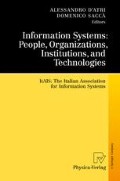Abstract
A transaction is a bilateral exchange between two parties in which goods are delivered in return for payment. In virtual enterprise environments, transactions are the principal means of collaboration among the enterprise members, as well as the mechanism with which the enterprise provides its products to its external clients. In this paper we examine the concept of transactions in virtual enterprises. We define transactions as recursive processes (similar to supply chains), and we formalize the concept of transaction cost. We then examine transaction failure and transaction risk, which lead us to the concept of transaction expected loss. The overall goal is to allow enterprise members to launch those transactions that minimize their expected losses. We also discuss how initiating redundant transactions can further reduce expected losses.
Access this chapter
Tax calculation will be finalised at checkout
Purchases are for personal use only
Preview
Unable to display preview. Download preview PDF.
References
C.E. Bonferroni. Teoria statistica delle classi e calcolo delle probabilità. Istituto Superiore di Scienze Economiche e Commerciali di Firenze, 8: 1936, 1–62.
L.M. Camarinha-Matos and H. Afsarmanesh. The Virtual Enterprise Concept. In Proceedings of the IFIP TC5 WG5.3 / PRODNET Working Conference on Infrastructures for Virtual Enterprises: Networking Industrial Enterprises, IFIP Conference Proceedings, Vol. 153, 1999, pages 3–14.
A. D’Atri and A. Motro. VirtuE: a Formal Model of Virtual Enterprises for Information Markets. International Journal of Intelligent Systems, Vol. 30, No. 1, February 2008, pages 33–53.
A. De Moivre. Doctrine of Chances – A Method for Calculating the Probabilities of Events in Plays. Pearson, London, 1718.
A.K. Elmagramid. Database Transaction Models for Advanced Applications. M. Kaufmann Publishers, San Mateo, California, 1992.
P. Grefen. Transactional Workflows or Workflow Transactions? In Proceedings of DEXA 02, 13th International Conference on Database and Expert Systems Applications, Lecture Notes in Computer Science, Vol. 2453, Springer, 2002, Pages 327–349.
G.E. Smith, M.P. Venkatraman , R.R. Dholakia. Diagnosing the Search Cost Effect: Waiting Time and the Moderating Impact of Prior Category Knowledge. Journal of Economic Psychology, Vol. 20, 1999, pages 285–314.
Author information
Authors and Affiliations
Corresponding author
Editor information
Editors and Affiliations
Rights and permissions
Copyright information
© 2009 Physica-Verlag Heidelberg
About this chapter
Cite this chapter
D’Atri, A., Motro, A. (2009). Virtual Enterprise Transactions: A Cost Model. In: D'Atri, A., Saccà, D. (eds) Information Systems: People, Organizations, Institutions, and Technologies. Physica-Verlag HD. https://doi.org/10.1007/978-3-7908-2148-2_20
Download citation
DOI: https://doi.org/10.1007/978-3-7908-2148-2_20
Published:
Publisher Name: Physica-Verlag HD
Print ISBN: 978-3-7908-2147-5
Online ISBN: 978-3-7908-2148-2
eBook Packages: Business and EconomicsBusiness and Management (R0)

